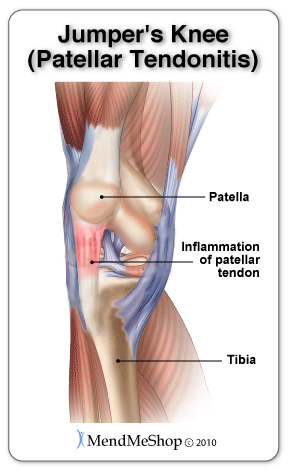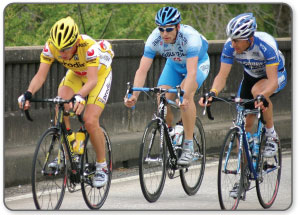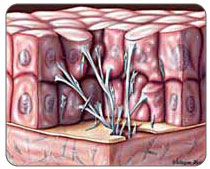Tendonitis of the Patella (also known as Jumper's Knee and Sinding-Larsen-Johansson disease) is a painful condition affecting the patellar tendon (also called the patellar ligament or anterior ligament) in the knee joint. Like all forms of tendinitis, patellar tendinitis is a condition that can flare up and subside over a period of time. Inflammation in the patellar tendon is often due to irritation and/or micro-tearing of the collagen fibers. When the fibers tear, they become weaker, inflamed and swollen causing pain and tenderness in the area.

Tendons, by nature, receive very little blood flow. This prevents certain areas of the tendons from getting adequate blood supply in order to repair and maintain themselves. This makes tendons prone to micro-tearing and inflammation if they are strained or overused.
There are 2 types of tendonitis, acute and chronic. Acute tendonitis refers to inflammation that comes on suddenly, usually from a tendon strain or overloading it during exercise. Chronic tendonitis occurs over time and generally results from long term repetitive use of the patella tendon. With both types of patellar tendinitis, scar tissue develops on the tendon as the tears begin to heal. This scar tissue mends the tears in an abnormal way leaving the collagen fibers weaker and less flexible and its presence can result in re-tearing the same small areas over and over.
The patellar tendon connects the shin bone (tibia) below the (patella) kneecap to the quadriceps femoris tendon above the kneecap. The fibres of the patellar tendon encase the patella itself, allowing it to glide up and down.
The patellar tendon is responsible for extending the knee with the help of the quadriceps femoris tendon which passes down both sides of the patella and the quadriceps femoris muscle in the upper leg - a process known as the quadriceps mechanism.
Other conditions which can be a cause of anterior knee pain are commonly confused with patellar tendonitis. These conditions include quadriceps tendonitis, chondromalacia, patello-femoral subluxation and hyper-pressure, fat pad impingement or Hoffa's Syndrome, and patello-femoral arthritis.
Patella Tendonitis is usually caused by repetitive use of the patellar tendon, but can also be caused by trauma such as a blow to the knee. This condition is most common in an athlete who is involved in "jumping" sports such as basketball, gymnastics, figure skating, and volleyball. Other risk factors include:

The best way to treat patellar tendonitis is to rest the area, especially avoiding the particular activity that produced the condition. If the strain was minor, the body should be able to heal the tendon fibers normally. Unfortunately, this is not the usual result, due to the injured tendon being used instead of rested.

The body heals the injured patellar tendon fibers by binding them together with fibrotic adhesions, or scar tissue. This is a normal, protective response of the body, done in an attempt to prevent further damage to the injured area. Unfortunately, this leads to inflexibility in the knee and possibly chronic knee problems.
The trick to healing any tendon injury is getting it to heal with minimal scar tissue formation - one of the reasons why we recommend use of the TShellz Wrap®. Even with optimum healing there is always less elasticity in a previously injured tendon. You need to make sure you heal this as best you can - that way, your chance of re-injury down the road is much lower than average. If not treated properly, persistent symptoms will occur, which may eventually lead to corrective surgery.
Using cold compression immediately following a Medial Collateral Ligament tear reduces pain and swelling but also reduces soft tissue damage (ie. muscle, tendon and ligament damage)
An ice pack or frozen bag of peas will help you minimize pain and swelling following a PCL tear and after any further re-injury (which is common due to the instability of the knee).
Cold works by interrupting and slowing nerve and tissue function in the damaged area. This is important because once blood vessels are damaged, they can no longer carry oxygenated blood to the damaged PCL so this tissue begins to break-down.
Cold temperatures slow tissue function thereby reducing the amount of damage occurring. Furthermore, because the cold numbs the nerves, it will help reduce pain.
After the inflammation and swelling below your kneecap and around your patellar tendon is gone, you can begin to treat your entire knee with Circulation Boost, or Circulatory Boost. Circulatory Boost increases the amount of blood that flows naturally to soft tissue in your knee. Soft tissue includes muscles, tendons and ligaments; increased blood supply to damaged soft tissue is how your body heals itself.
By treating yourself with Circulation Boost you can increase your body's blood supply to the knee and your bodys natural healing power. In addition, the fresh blood flow whisks away dead tissue and toxins that have built up from the tissue damage of patellar tendinitis leaving the area clean and able to heal faster. Our Knee TShellz Wrap® provides a highly effective, non-invasive, non-addictive pain relief and blood flow booster that is safe for use at home.
During your recovery, you will probably have to modify and/or eliminate any activities that cause pain or discomfort in your knee until your pain and inflammation settle. Taking the time to care for your knee properly will have your knee back to normal faster and allow you to get back to the activities you enjoy.
The more diligent you are with your treatment and rehabilitation, the faster you will see successful results! With these 3 easy therapies you will notice incredible results in your knee.
Click HERE to Go To Our Online Store We take all major credit cards and Paypal. If you are on your mobile phone, Click to Call Our Office (toll free continental NA).
Our customer service lines are open 5 days a week helping people understand their injuries and how to treat them. Simply call toll free 1-866-237-9608 to talk with one of our knowledgeable Product Advisors. They have the ability to answer questions and even put together a treatment plan for you.
Product Advisors are available 9:00 am to 5:00 pm Eastern Standard Time Monday to Friday.
Learn more about Knee Surgery and Post-Surgery Recovery
Learn more about how the TShellz Wrap® stimulates blood flow.
Learn more about Ice vs Heat Treatments for Knee Strain
During your recovery, you will probably have to modify and/or eliminate any activities that cause pain or discomfort at the location of your soft tissue injury until the pain and inflammation settle. The more diligent you are with your treatment and rehabilitation, the faster you will see successful results!
Please be aware that this information is neither intended nor implied to be a substitute for professional medical advice. CALL YOUR HEALTHCARE PROVIDER IMMEDIATELY IF YOU THINK YOU MAY HAVE A MEDICAL EMERGENCY. Always seek the advice of your physician or other qualified health provider before using any of our outstanding products to make sure they are right for you and your condition or if you have any questions regarding a medical condition. Always see your doctor for a proper diagnosis as there are often many injuries and conditions (some very serious) that could be the cause of your pain.
© 2025 In.Genu Design Group, Inc. Contact Us